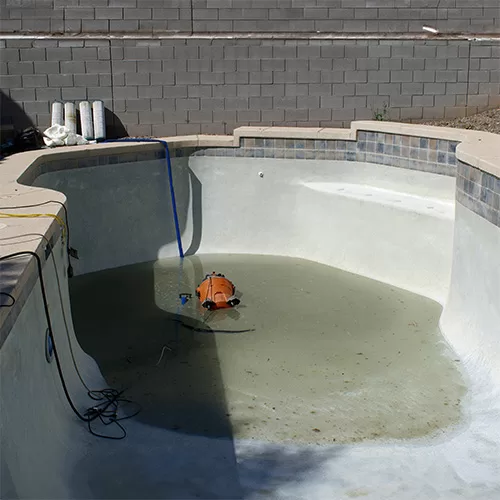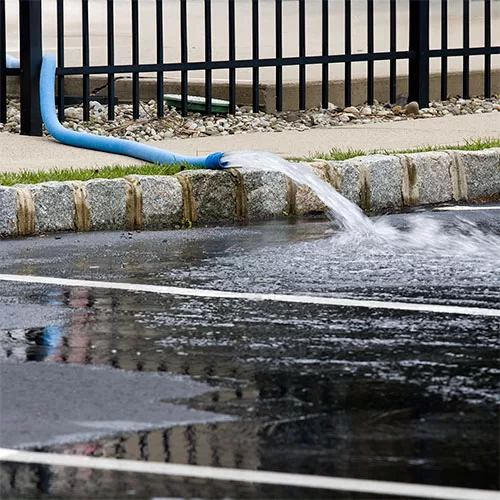FREE Standard Shipping On All Orders $100 or More!*

How to Drain a Swimming Pool
A simple enough question on the surface, but around here, we always dive deeper into a subject. So when we talk about how to drain a pool, first we want to explore why you would do such a thing, and then cover the when, where, and what of draining a swimming pool.
Draining a pool safely must also be a large part of the conversation, because if done improperly or haphazardly, unfortunate damage or effects can happen! You don't want to kill the lawn, flood the neighbors, burn out the pump, ruin the pool liner, or worst of all - pop the pool out of the ground!
When to Drain Your Pool
- Very bad algae conditions with a heavy pool stains.
- Very high TDS (5-10,000 ppm) or very high Cyanuric Acid (100-150 ppm)
- To perform repairs or cleaning to pool surfaces or liner replacement.
If a partial pool draining can accomplish the result, a complete draining of the pool can be avoided. When suitable, drain the pool one-third to one-half, and then refill quickly. Make sure that the pH of the water is between 6.0 and 8.0, and that high levels of chlorine or biguanide sanitizers are not present in the water before draining.
Should You Drain Your Pool?
- Vinyl pools should avoid draining completely to the floor, your vinyl liner can relax and possibly wrinkle or shrink in some areas. If necessary for cleaning or repair, re-set the liner with a Cyclone liner vacuum while refilling.
- Fiberglass pools are usually ok to drain for short periods, but could shift or pop-up, if drained fully with a high water table or expansive soils. The topography of the surrounding area, local elevation, and recent rainfall can all be risk factors.
- Concrete pools are usually stable when empty, but to be safe, open up the hydrostatic relief plugs in the floor and hydrostatic valve in the main drain. Avoid keeping empty for prolonged periods of time.
Best Time to Drain a Swimming Pool
- Avoid draining a pool before, during or after heavy rain storms that raise a high water table.
- Wait to drain your pool until you are immediately ready to start repairs, to reduce time spent empty.
- Warm weather temperatures are best; 55-85° F. Cold temp exposure can be bad for pool surfaces.
How to Drain an Inground Pool

- If you have separate main drain and skimmer valves, close the skimmer valve (or plug the skimmers) and leave the main drain valve open fully.
- Place the filter multiport valve in the Recirculate position and turn on the pump, after you roll-out the backwash hose; monitor pool draining closely.
- Eventually the pool drain will begin to suck air, with about 6-9" of water left in the deep end, if you're lucky. Use a small cover pump for the 1000 gallons remaining.
- If your main drain is connected to the skimmer, with one hole in the bottom of the skimmer, you can continue to pump the pool nearly empty by plugging the top of the skimmer with an expansion plug, or a threaded plug with o-ring.
- The easiest method is to connect a threaded hose adapter into the hole which goes to the pump, and connect a primed, "tight" vacuum hose to it.
To allow high water table water to flow into a concrete pool, located and remove a few of the hydrostatic relief plugs in the floor and hydrostatic valve in the main drain pot. In some cases, you can get nearly all the water out with the filter pump, but normally you will be left with several hundred gallons at least, when using the pool filter pump to drain a pool.
A more reliable option is to use a submersible pump, or a pool cover pump, to drain your pool. When resurfacing the pool, you will need a small pump anyway, to get out the last 50 gallons. Small submersible pumps fit inside of the main drain pot, to get every last gallon.
Where to Drain a Swimming Pool

- Clean and balanced water can be directed into the storm drain if you have a curb/gutter type of sewer on your street.
- Pool water that has been chlorine neutralized and pH balanced can be pumped downhill from the pool, monitoring for erosion or over-saturation.
- Pump away from the pool, 50' to 100' or more. Too much water pumped beneath your pool can cause a problem!
Remember to move the hose often as needed, to avoid over-saturation, when pumping into large grassy areas or wooded areas. Avoid downhill courses that erode hillsides. For submersible pumps, run discharge hose out of the shallow end, to reduce resistance from a vertical lift over the deep end wall. Avoid flooding downhill neighbors!
Draining an Above Ground Pool
Like inground vinyl pools, draining an above ground vinyl pool is discouraged, because the vinyl liner may shrink or relax while drained, and can wrinkle or rip when being refilled. However this can often be avoided with careful work to pull-out wrinkles during refill.

If you are draining to change the water, or for very bad algae conditions, consider leaving 4-6" of water in the pool, treating the water and/or scrubbing the vinyl, and then refilling the pool with fresh water.
- Above ground pools typically have one pipe (hose) out of the pool, and one hose returning to the pool. Because there is no main drain on most above ground pools, you will only be able to lower the water to the bottom of the intake or skimmer, using your above ground pool filter system.
- To drain an above ground pool, either a). Use small submersible electric pump and garden hose, or b). Start a siphon with your vacuum hose / head on the pole, or a siphon using garden hose(s).
- Pumping the water far from the pool's edge is best, so as not to oversaturate the soil supporting the pool.
- Monitor the draining and the discharge. Siphoning can take days, a small submersible pump will take 6-12 hrs.
- Work fast to clean the bottom if needed, and re-fill the pool as quickly as possible.
Every pool needs to be drained every once in awhile. If you are draining your own pool, monitor the situation well, and be aware of the potential pitfalls, as outlined above. In addition to draining quickly, it is also recommended to re-fill the pool as fast as possible, using two hoses, even borrowing water from a neighbor (with their permission, of course!).